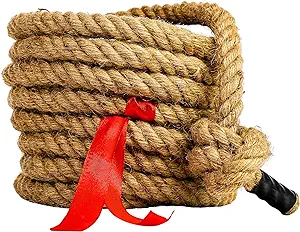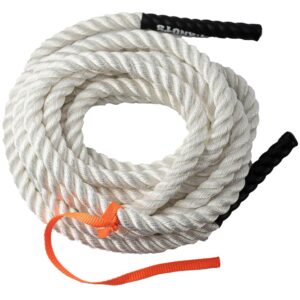Ever found yourself in a heated tug of war battle, only to have the rope snap mid-pull? Talk about a buzzkill! Whether you’re planning the ultimate backyard showdown or gearing up for a company picnic, choosing the right tug of war rope can make or break your event. But with so numerous alternatives out there, how do you know which one to pick? Don’t worry, we’ve got you covered.
In this guide, we’ll walk you through everything you need to know about selecting the perfect rope for your epic tug of war face-off. Get ready to dominate the field and leave your opponents in the dust!
What to Look for in a Tug of War Rope
When you’re on the hunt for the perfect tug of war rope, there are a few key things you’ll want to keep an eye out for. Let’s dive into what makes a great rope for this classic game of strength and teamwork.
Material Matters
First things first, you’ll want to pay attention to what the rope is made of. Synthetic materials like polypropylene or nylon are popular choices because they’re durable and won’t rot when wet. But if you’re going for a more traditional feel, manila rope is a classic option. Just remember, natural fibers might not hold up as well in damp conditions.
Size It Up
When it comes to rope thickness, bigger is usually better for tug of war. You’ll want something that’s easy to grip, typically between 1.5 to 2 inches in diameter. Length-wise, aim for about 100 to 150 feet. This gives you plenty of rope for teams to spread out and really dig in their heels.
Safety First
Don’t forget about safety features! Look for ropes with flags or markers in the middle to help teams know where they stand. Some ropes even come with built-in loops at the ends for easier gripping. These little extras can make a big difference in gameplay and prevent accidents.
Durability is Key
Lastly, you’ll want a rope that can take a beating. Check for reinforced ends to prevent fraying, and make sure the rope has a high tensile strength. After all, you don’t want your epic tug of war battle to end with a snapped rope!
Remember, the right rope can make or break your tug of war experience. So take your time, consider these factors, and you’ll be well on your way to finding the perfect rope for your next pull-off!
Types of Ropes for Tug of War Competitions
When it comes to tug of war, not all ropes are created equal. You’ll want to choose the right type to ensure a fair and exciting match. Let’s dive into the most common rope varieties you’ll encounter in competitions.
Natural Fiber Ropes
Natural fiber ropes are the traditional choice for tug of war. You’ll often see these in official tournaments and casual games alike.
Manila rope is a popular option. It’s made from abaca fibers and offers excellent grip and durability. You’ll love how it feels in your hands — sturdy and slightly rough. Hemp rope is another natural contender, known for its strength and resistance to stretching.

Synthetic Ropes
If you’re looking for something more modern, synthetic ropes might be your jam. These bad boys are typically made from materials like polypropylene or nylon.
Polypropylene ropes are lightweight and water-resistant – perfect for those impromptu beach competitions. Nylon ropes, on the other hand, are super strong and have some give to them, which can make for an interesting game dynamic.

Specialized Tug of War Ropes
For the serious competitors out there, you might want to consider ropes specifically designed for tug of war. These often combine the best of both worlds – natural and synthetic fibers.
These specialized ropes usually have a synthetic core wrapped in natural fibers. You get the strength and weather resistance of synthetics with the classic feel and grip of natural materials. It’s like the superhero of tug of war ropes!
Remember, whichever rope you choose, make sure it’s thick enough (usually 1.5 to 2 inches in diameter) and long enough for your team size. Happy tugging!
How to Take Care of Your Tug of War Rope
Taking care of your tug of war rope isn’t rocket science, but it does require a bit of attention. Here’s how you can keep your rope in top-notch condition for all those epic battles to come.
Clean it up, buttercup
After a sweaty match, your rope’s bound to be a bit grimy. Give it a good rinse with some mild soap and water. Don’t go crazy with harsh chemicals – they might weaken the fibers. Once you’ve got it clean, hang it up to air dry completely. Stuffing a damp rope in storage is like inviting mold to a party – not cool.
Store it right, sleep tight
When your rope’s not in use, find it a cozy spot to rest. A cool, dry put absent from coordinate daylight is perfect. UV rays can be pretty harsh on rope fibers, causing them to break down over time. Think of it as rope sunburn – ouch! If you’ve got a garage or storage shed, that’s ideal. Just make sure it’s not sitting in a puddle or pressed against anything that could damage it.
Handle with care, don’t despair
Your tug of war rope isn’t indestructible, so treat it nicely. Avoid dragging it over harsh surfaces or sharp edges. When you’re coiling it up, don’t twist it too tightly -that can stress the fibers. And hey, if you notice any fraying or weak spots, it might be time to retire that rope before someone takes an unexpected trip during your next match. Remember, a well-cared-for rope means safer, more fun tug of war battles for everyone!
Conclusion
So there you have it, folks – everything you need to know about picking the perfect tug of war rope. Remember, it’s all about finding that sweet spot between durability, grip, and comfort. Don’t skimp on quality, or you might end up with rope burn and bruised egos. Whether you’re gearing up for a backyard BBQ showdown or a serious competition, the right rope can make all the difference.
Now get out there and start pulling! Just don’t forget to stretch first – nobody wants to pull a muscle before the big tug. May the best team win, and may your rope game always be strong!




Pingback: How to Win at Tug of War: Tips and Strategies - sports to know